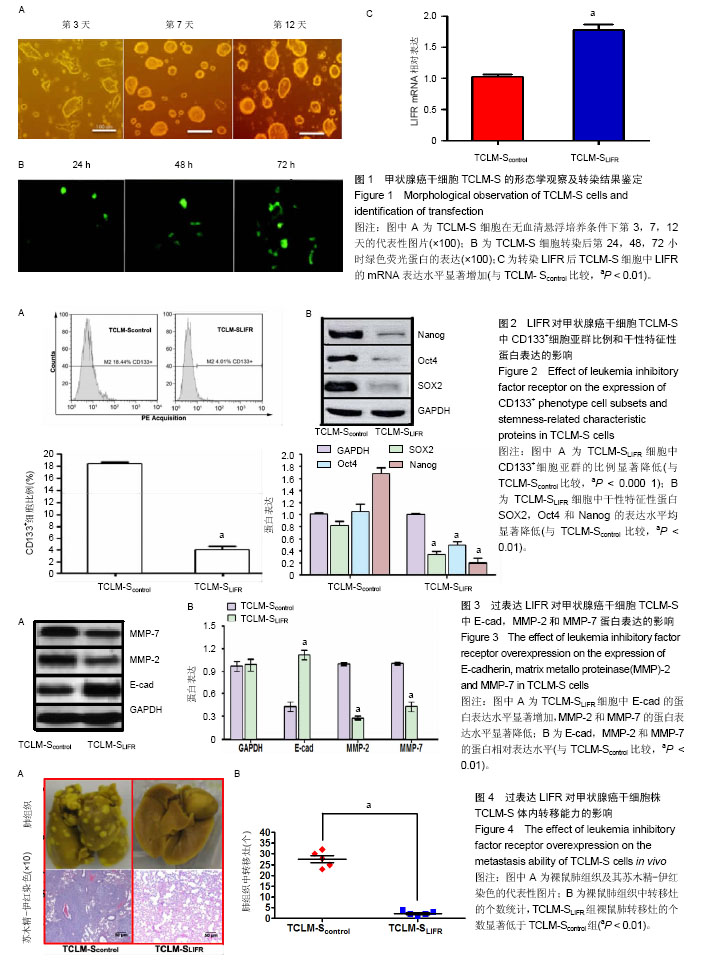中国组织工程研究 ›› 2018, Vol. 22 ›› Issue (9): 1376-1381.doi: 10.3969/j.issn.2095-4344.0467
• 肿瘤干细胞 cancer stem cells • 上一篇 下一篇
过表达白血病抑制因子受体对甲状腺癌干细胞干性维持及体内肺转移能力的影响
张振华1,苏自杰1,阚云珍2,刘秋雨2
- 河南省人民医院,1甲状腺外科,2病理科,河南省郑州市 450003
Effects of leukemia inhibitory factor receptor overexpression on stemness maintenance and lung metastasis in vivo of thyroid cancer stem cells
Zhang Zhen-hua1, Su Zi-jie1, Kan Yun-zhen2, Liu Qiu-yu2
- 1Department of Thyroid Surgery, 2Department of Pathology, Henan Province People's Hospital, Zhengzhou 450003, Henan Province, China
摘要:
文章快速阅读:
.jpg)
文题释义:
白血病抑制因子受体(leukemia inhibitory factor receptor,LIFR):是极其重要的肿瘤转移抑制因子,其在多种肿瘤中表达失调,如LIFR在甲状腺癌和乳腺癌中表达缺失,且LIFR的缺失与乳腺癌的淋巴结阳性状态、肿瘤分级增加、远处转移风险的增加及总体生存率的降低密切相关。通过过表达LIFR可抑制多种恶性肿瘤的复发与转移。
上皮间质转化:研究显示肿瘤发生复发转移的过程中,存在上皮间质转化,即存在上皮细胞向间质细胞转化的过程,上皮间质转化使肿瘤细胞具有更强的侵袭和转移能力,该过程使肿瘤细胞拥有干细胞特征,减少细胞的凋亡和衰老,并促进肿瘤细胞的免疫抑制。在肿瘤发生发展的初期,上皮细胞经过上皮间质转化过程转化为原位癌,后续肿瘤细胞经上皮间质转化过程向周围组织扩散,并经血管或淋巴管向远处组织发生迁移,最终形成转移灶。
背景:甲状腺癌干细胞是甲状腺癌发生复发转移的关键,白血病抑制因子受体(leukemia inhibitory factor receptor,LIFR)在多种恶性肿瘤中表达下调,且过表达LIFR可抑制恶性肿瘤的复发与转移。
目的:探讨LIFR对甲状腺癌干细胞干性维持和体内肺转移能力的影响。
方法:收集转移性甲状腺癌患者的肺转移灶,分离培养原代甲状腺癌细胞TCLM,经无血清悬浮培养形成肿瘤细胞球,流式分选筛选出CD133+表型的转移性甲状腺癌干细胞细胞亚群TCLM-S。将包含LIFR的重组慢病毒过表达质粒及其阴性对照空载体质粒分别以病毒/细胞数量=20的比例感染甲状腺癌干细胞TCLM-S,经2.0 mg/L嘌呤霉素筛选,成功构建稳定表达LIFR或阴性对照的TCLM-SLIFR和TCLM-Scontrol细胞株。qRT-PCR检测LIFR在TCLM-SLIFR和TCLM-Scontrol细胞中的表达,流式细胞术检测TCLM-SLIFR和TCLM-Scontrol细胞中CD133+细胞亚群的比例,Western Blot检测TCLM-SLIFR和TCLM-Scontrol细胞中干性相关因子SOX2、Oct4、Nanog及肿瘤侵袭和转移相关蛋白E-cad、MMP-2、MMP-7的表达。将TCLM-SLIFR和TCLM-Scontrol细胞分别经尾静脉注射到BALB/c裸鼠体内,构建甲状腺癌干细胞裸鼠肺转移模型,观察过表达LIFR对裸鼠体内肺转移能力的影响。
结果与结论:与TCLM-Scontrol细胞相比,TCLM-SLIFR细胞中LIFR的表达显著增加,流式分选技术检测CD133+干细胞亚群的比例显著降低,干细胞干性相关因子SOX2、Oct4和Nanog的蛋白表达显著降低,肿瘤侵袭和转移相关蛋白E-cad的表达显著增加,MMP-2和MMP-7的表达显著降低,裸鼠体内肺转移的数量显著降低。结果表明,过表达LIFR可显著抑制甲状腺癌干细胞的干性和体内肺转移能力。
中国组织工程研究杂志出版内容重点:干细胞;骨髓干细胞;造血干细胞;脂肪干细胞;肿瘤干细胞;胚胎干细胞;脐带脐血干细胞;干细胞诱导;干细胞分化;组织工程
ORCID: 0000-0003-2036-7267(张振华)
中图分类号:

.jpg)